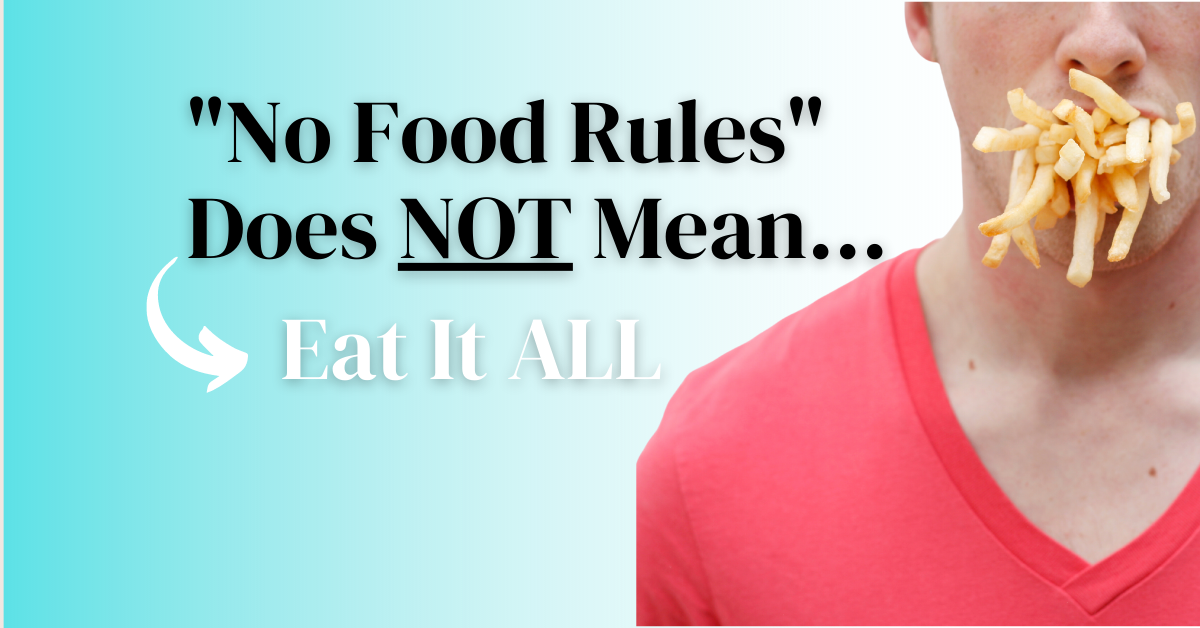In recent years, the concept of “no food rules” has gained significant popularity as a way to promote a healthy relationship with food. The idea is to move away from strict diets and rigid eating patterns and instead embrace a more intuitive and flexible approach to nourishing our bodies. While this approach is undoubtedly a step in the right direction, it is essential to understand that “no food rules” doesn’t equate to a free-for-all when it comes to our eating habits. In this article, we’ll explore what the no foods rules movement is and is NOT.
Understanding the "no food rules" movement
The “no food rules” movement encourages individuals to reject the idea of labeling foods as “good” or “bad” and, instead, listen to their bodies’ needs. This is not arguing that some foods are more nutrient-rich than others. It simply is promoting the freedom to enjoy a wide variety of foods without guilt or shame to help individuals find THEIR perfect balance with eating. This approach also encourages mindfulness, allowing individuals to focus on internal cues of hunger, fullness, and satisfaction. Overall, it supports the notion that all foods can fit into a healthy eating pattern when consumed in moderation.
What "no food rules" ISN'T....
While the concept of “no food rules” is well-intentioned, it’s crucial to understand that it does not give us permission to consume unlimited quantities of any food. Unfortunately, some people misinterpret this message and use it as an excuse for overeating or overindulging in unhealthy food choices excessively. After all, most individuals struggling with their relationship with food are used to dichotomous, all or nothing swings with eating. This misunderstanding can lead to negative consequences, both physically and mentally, and sends the reconfirming message that one cannot operate without hardcore diet rules – which is absolutely false.

The power of permission.
Due to the misinterpretation of “no food rules” people avoid even attempting to explore a more flexible eating approach. It can feel scary if dieting is all you’ve known! But those that truly lean into the process quickly realize what I call the “power of permission”.
When you truly give yourself permission to mindfully (not mindlessly) eat what you feel you both want and need when you’re hungry, the crazed compulsive pull you used to feel to such “bad” foods actually begins to fade. Knowing that if you truly did want that ice cream, cookie, or other that you CAN have it mindfully, it takes away the shiny glow and angelic hymns away from your fantasized food and it becomes, well….just another food!
What people need to know is that what you feel you want and need to eat at your meals initially WILL change over time. You may find yourself wanting and deciding to have something on your “forbidden foods” list the first week, maybe even more than once – mindfully. But then you may not have it the next week. So if you’re panicking about how the heck you’re going to lose weight if you mindfully have a few cookies as you begin this new relationship with food, I promise things only continue to settle into their rightful balanced place over time.
Here’s an example scenario of what happens 99% of the time: You have a cookie after lunch and are loving the permission and are actually enjoying what you eat. You don’t even binge eat later in the day!
But then you might find after a few days of this you find yourself feeling a little more sluggish in the afternoons, or maybe you aren’t as hungry for your later meals as much as you’d prefer to be. You’ll then find yourself naturally wanting to make a change to how often you have that cookie after lunch, and it will NOT feel like a food rule. You’ll be making this decision because you actually want to feel good, not be good. BIG difference! It will feel like an objective, natural, intuitive eating decision to have less cookies during the week instead of a hardcore food rule you feel you “should” follow to help you lose weight.
Let's talk balance...
Finding balance is key. Even within a flexible eating approach, it’s essential to ensure that our overall diet consists of a variety of nutrient-dense foods, including fruits, vegetables, whole grains, lean proteins, and healthy fats.
While no food should be off-limits, it’s crucial to practice moderation and consider the nutritional value of the foods we choose to consume. How can you incorporate foods that are both nutrient rich AND conveniently delicious? With today’s resources, there is NO excuse not to be able to find something healthy and enjoyable.
Now, what balance means for you will differ from others, and will differ at different stages as you cultivate a healthier relationship with food. My advice is to do your best to eat more real food that you absolutely enjoy, but honor your needs for some fun foods too. Listen to how ALL foods make you feel, even the nutrient-rich foods. Your body is always giving you feedback.

Listen to your body.
One of the fundamental principles of a flexible eating approach is listening to our bodies’ signals of hunger and fullness. It’s important to pay attention to internal cues and eat when hungry, stopping when comfortably satisfied. This practice helps prevent mindless eating and promotes a healthier relationship with food. Tuning in to how specific foods make us feel can also guide us in making choices that support our overall well-being.
But warning: this doesn’t always come easy. Sometimes it’s a completely relearning process as decades of dieting can really put a wrench on our body’s ability to tune in to those hunger fullness cues and you may totally suck at knowing your hunger or fullness cues at first. (Here is a helpful article if you find you aren’t feeling those cues). You may be better at tuning into one versus the other, or you may need help defining your hunger and fullness cues, and you know what? That’s ok. That’s why we’re here because this whole “flexible eating approach” sounds easy but it’s not always easy to implement.
"No food rules" is NOT anti-structure!
Another misinterpretation of “no rood rules” is that there is no structure and you “wing it” all the time. Who in their right mind in today’s world can just “wing it” with their eating?? Practically no one! You’ll still find an eating pattern, but one that works for you. Maybe you find yourself hungry 3-4 times per day, for you maybe that’s 8am, 1pm, and 5:30pm. There’s your eating structure to which you want to ensure you HAVE food available that you want and need, which means – yes! You still will need to plan some things out! Being proactive with your menu planning is NOT a restrictive act of eating. It’s a proactive move to ensure you have nourishing foods available that YOU both enjoy and that feel good with your body!
Let's wrap this up...
“No food rules” represents a positive shift away from strict diets and encourages a more intuitive and flexible approach to eating. However, it’s crucial to understand that this approach does not mean eating without any consideration for balance or moderation. By embracing a balanced perspective, practicing portion control, and listening to our bodies’ cues, we can enjoy a wide variety of foods while maintaining a healthy lifestyle.
If this all sounds a little too good to be true OR too overwhelming, consider becoming a Diet Freedom member. Why? Because we KNOW it’s a mental game and we’ve got the structure to give you the tools, the science, and practices you need to truly implement a more flexible eating approach into your everyday life and help shave YEARS off you trying to figure it out on your own. We got you!
xoxo
Shelby

Author Shelby McDaniel
Hi! I’m Shelby and I’m a food lovin’ nutritionist but…I’m not a regular nutritionist. I’m an intuitive eating specialist, eating psychology practitioner, and Certified Mind Body Nutrition Coach, here to free you from diet culture once and for all! Because you deserve peace with food, eating, and your body. (Yes, I'm talking to YOU!)



